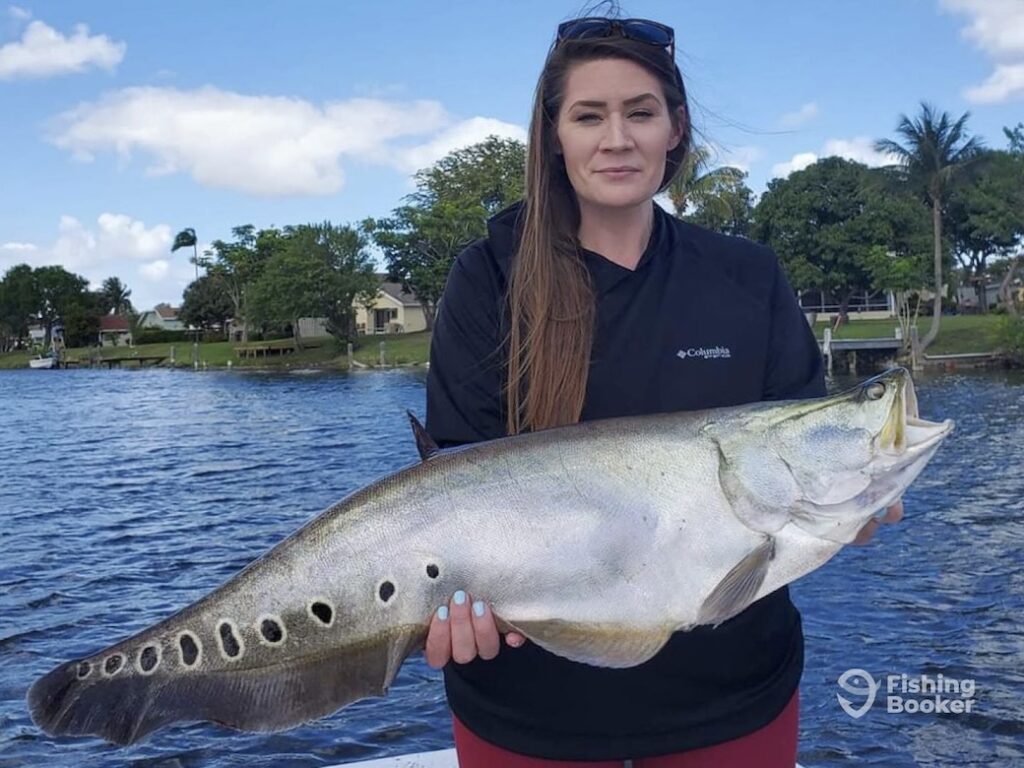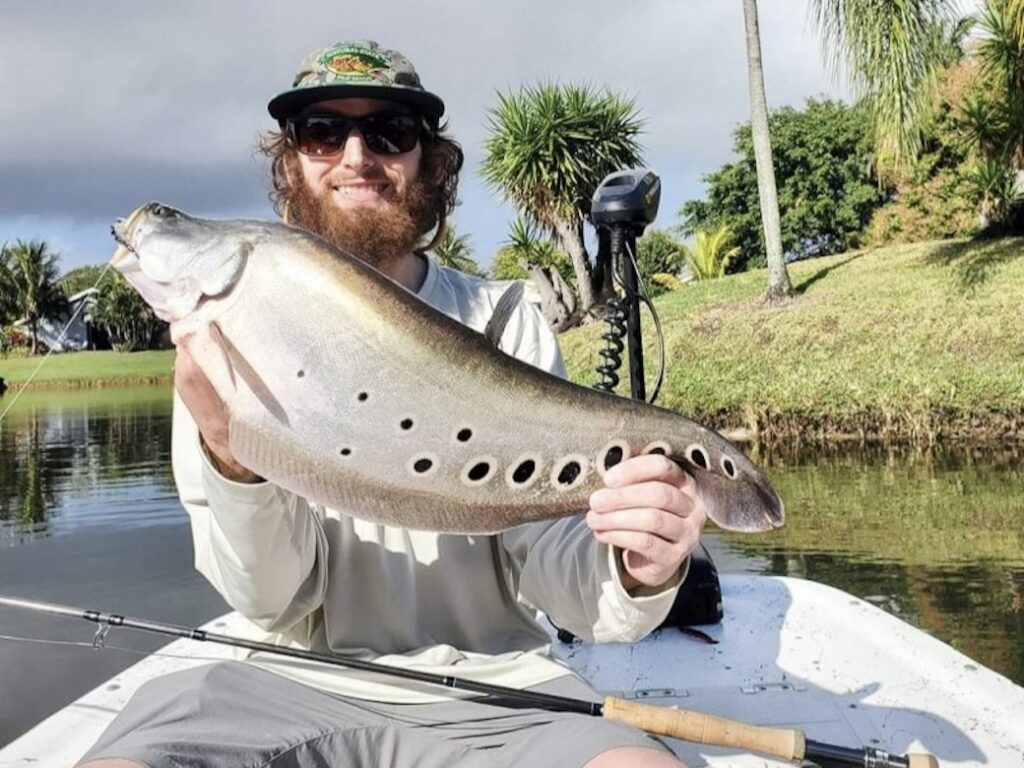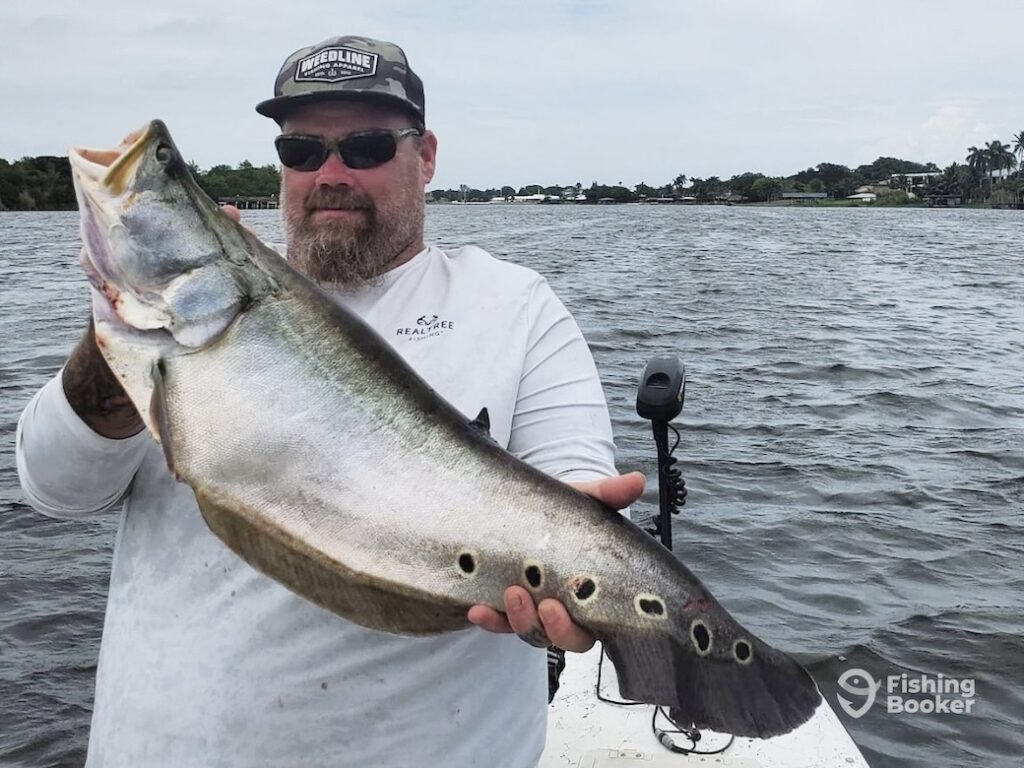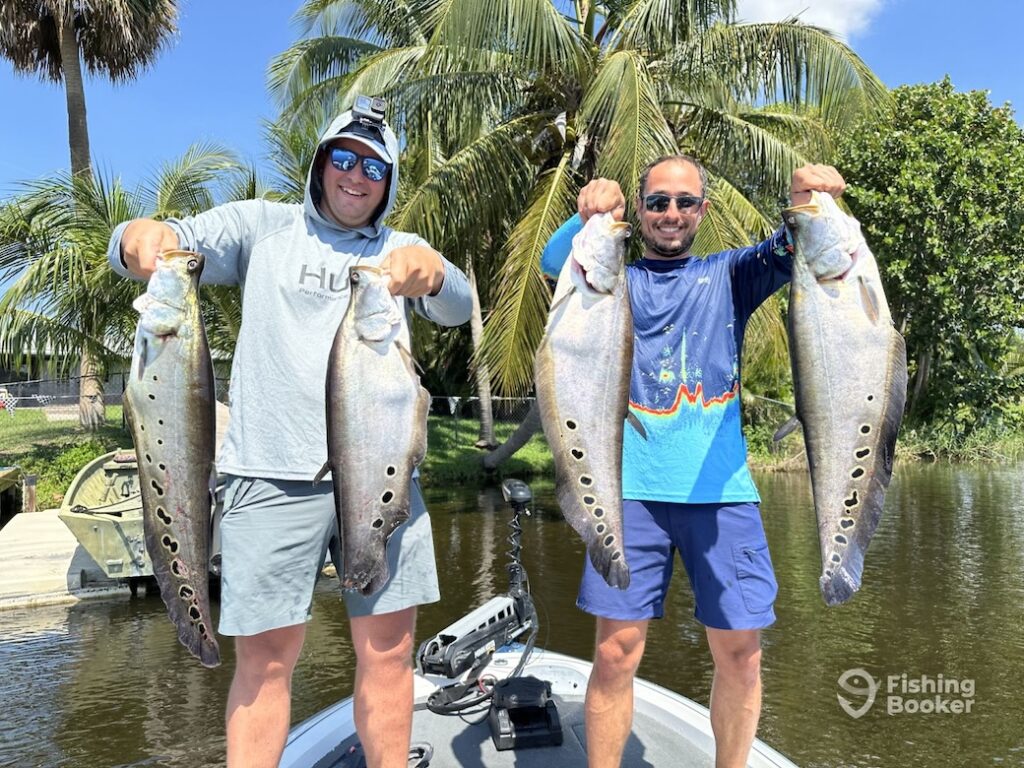Fishing for Clown Knife Fish is as close as angling comes to a circus act. These swimming blades are known for their high-flying acrobatics. Just when you think you’ve snared one, they’ll leap right out of your net. But the real trick up their sleeve? They can slice through the water both forwards and back, quick enough to pull their own disappearing act.

Think we’re laying it on a little thick? When it comes to Clown Knife Fishing, it’s hard not to. These peculiar fish come with a serious edge. For us, the hardest part is choosing between puns. For you, it means casting so many times that you won’t know whether to laugh or cry.
Now, let’s quit clowning around – you’ve got a fish to catch.
How to Identify Clown Knife Fish
Clown Knife Fish (Chitala ornata) – aka Clown Featherback – are part of the Featherback family, known for their eel-like bodies and long, feathered fins. True to their name, these fish often sport a series of clown-like spots on their flanks. In Thailand and Cambodia, locals sometimes call them “Spotted Featherbacks.”

In the wild, they’re native to freshwater systems across Southeast Asia, particularly Thailand, Cambodia, Laos, and Vietnam. But Clown Knife Fish accidentally made their way into Florida’s waterways – most likely when someone dumped their aquarium pet into a local canal. Since then, the species has thrived and earned itself a special place among game fish. Florida is the only state in the US where you can catch them!
When it comes to their appearance, these fish really are freakish. The slight curve of their bodies and silver scales make them look like Arabian swords. Their humped backs taper off to a fine point, leaving the fish unsheathed where you would normally see a tailfin. Most Clown Knife Fish feature 6–10 dark spots, though some have fewer or can be totally spotless. As if all that wasn’t enough to make these fish stand apart, the fanlike fin on their underside allows them to glide seamlessly forward and backward.
Clown Knife Fish average 2–3 feet long and weigh 5–10 pounds. Anything over 10 pounds is considered a trophy in Florida. However, in their native range, they can reach up to 4 feet and weigh over 20 pounds.
Best Clown Knife Fish Fishing Spots
These showstoppers only work their magic in a handful of places – some of them far and wide. The good news is, you don’t have to brave exotic jungles and wetlands just to find them. For some of us, the circus ring is just a hop, skip, and a jump away.
Lake Ida and Lake Osborne, Florida

If Clown Knife Fish fishing has a US capital, this is it. Located in Palm Beach County, Lake Ida and the connected Lake Osborne chain are famous for holding one of the most stable populations of Clown Knife Fish outside of Asia. These lakes are shallow, warm, and brimming with bait fish that Clown Knives love.
Anglers here target them year-round, but the warm summer months (May–September) tend to be especially productive. As an invasive species, Clown Knife Fish have no size or bag limit in Florida. In fact, you’re encouraged to keep your catch rather than release it.
Palm Beach Canals, Florida

In general, you can’t go wrong fishing the labyrinth of canals that snake through Palm Beach County. The Clown Knives that thrive in Lake Ida and Osborne make their way into some of these canals, giving you all the more opportunity to catch them. On calm days, when the water is clear enough, sight fishing can be really productive near bridges and spillways.
Bung Sam Lan Lake, Thailand

In their native range, one of the most accessible places to catch Clown Knife Fish is Bung Sam Lan, a privately managed lake outside Bangkok. Think of this as the Disneyland of exotic freshwater fishing. It’s stocked with a variety of giant fish species, including Clown Knives. While it’s not a “wild” experience, it’s one of the most reliable ways to catch monster Clown Knife Fish while traveling in Asia.
The lake is open year-round, with professional guides and rental equipment available. Since it’s a stocked fishery, there are no size or bag limits, but catch-and-release is strongly encouraged.
Chaophraya River, Thailand

For a chance to catch these Clowns in the wild, you won’t have to venture past Bangkok. There are scores of untamed Clown Knife Fish (known as Pla Chitala) lurking in the backwaters, floodplains, and slow-moving stretches of the city’s mighty Chaophraya River. Here, they grow much larger than their Floridian cousins, sometimes topping 30 pounds.
The wet season (May–October) is prime time to fish for them, when floodplains expand and Clown Knife Fish move in to feed. Regulations vary, so your best bet is to fish with a local guide.
Tonlé Sap Lake, Cambodia

Southeast Asia’s largest freshwater lake, Tonlé Sap, is another native fishing spot for Clown Knife Fish. The seasonal flooding cycle creates ideal feeding conditions for them between August and November. Local anglers often use nets and traps, but rod-and-reel sportfishing is possible if you book a guided tour. In fact, we’d say hiring a guide is essential, not only to navigate these waters but to get your head around the regulations for them as well.
How to Fish for Clown Knife Fish
They may be clowns, but there’s no funny business here. Catching a Clown Knife Fish requires patience and finesse. As ambush artists, they know how to hide – and how to strike before a swift retreat. Rest assured, you don’t need a crystal ball to win your knife fight, just a very sharp skillset!

The first rule of thumb is to find their hiding spot. In Florida, this usually means locating cover in calm lakes, swamps, and backwater channels. Look for overhanging vegetation, fallen debris, dock pilings, or shaded canal edges. Just when you thought Clown Knives couldn’t get any freakier, it turns out they breathe air, making them perfectly comfortable in stagnant and low-oxygen areas that other species avoid.
The next rule is to match the menu. Use live or dead bait that mirrors what Clown Knife Fish are already feeding on. In South Florida, that typically means shad or golden shiners, although worms and tilapia are solid options, too. Shrimp patterns can also be surprisingly effective.
With these basics in mind, the rest is up to you. Light tackle is the name of the game, while some anglers go as far as fly fishing. You can target Clowns using live bait or artificials. If you’re partial to the latter, try small crankbaits, jerkbaits, or soft plastic swimbaits.
Remember to be patient: Many guides recommend simply letting live bait sit near cover – especially around submerged structures – for extended periods.
Lastly, brace yourself for the unexpected. When hooked, Clown Knife Fish can leap, buck, and slip. They’re notorious for spitting hooks and going airborne. Add to that their unusual shape, and they can throw some weird runs. They also tend to short strike, so be prepared for a second hook-set – they really are tricksters! Avoid slack in your line and maintain steady pressure to reel them in.
Clown Knife Fish Fishing Gear & Bait
Landing such slippery fish almost requires your own sleight of hand. For that, you need the right gear. A medium to medium-heavy spinning or baitcasting setup is ideal. Look for rods in the 6’6″–7′ range and 2500–4000 size reels.
Spool up with 10–20 lb braided line for strength and sensitivity. A 15–20 lb fluorocarbon leader is recommended since Clown Knives can be line-shy in clear water. You’ll want to use small but strong hooks, such as size 2–1/0 circle or J-hooks. A simple live bait rig with a split shot or small weight works well in lakes and canals.
As we mentioned, live shad and shiners are the gold standard. For artificial lures, opt for slim-profile baits like jerkbaits, swimbaits, or even inline spinners. Clown Knives often strike aggressively but miss, so consider treble-hooked lures for a better hookup ratio.
When to Fish for Clown Knife Fish

The circus may come and go, but Clown Knife Fish stick around their chosen lakes and canals in Florida all year. That said, they bite more aggressively during late spring through summer. As nocturnal feeders, they’re most active at night. This makes fishing for them ideal after dark, though you can get a lot of hookups during evening and in the early morning as well.
In Southeast Asia, peak season for them is during the wet season (roughly May–October). This is when rising water levels allow them to cover more ground and gorge themselves on bait fish. During the dry season, they retreat to deeper pools and channels, making them harder to target.
Clown Knife Fish FAQs
Clown Knife Fish: A Fool’s Errand?

Between their exotic looks and even more exotic habitats, Clown Knife Fish are sure to be one of the most memorable fish on your bucket list. Their acrobatics and slick maneuvers are just as jaw-dropping as their appearance, making these one of the more ambitious freshwater targets on light tackle. Whether you’re prowling the canals of Palm Beach or the floodplains in Thailand, you’re sure to encounter a unique challenge. Fishing for Clown Knives is truly no laughing matter!
Have you ever landed a Clown Knife Fish? Maybe it’s on your bucket list? Whatever your fascination with this fish, we’d love to hear from you in the comments below!
The post How to Go Fishing for Clown Knife Fish: The Complete Guide appeared first on FishingBooker Blog.
https://fishingbooker-prod-blog-backup.s3.amazonaws.com/blog/media/2025/09/22101536/clown-3.jpg
0 Comments
Enregistrer un commentaire